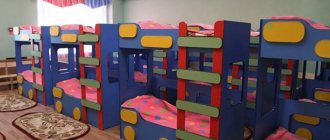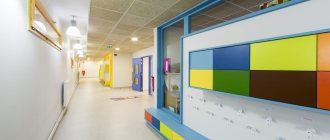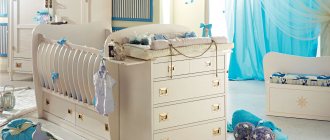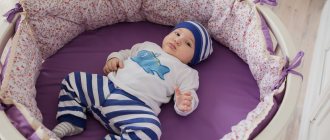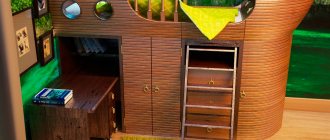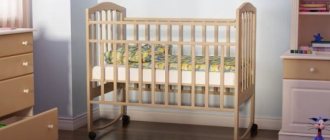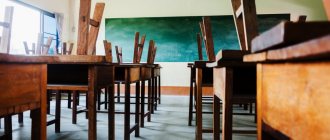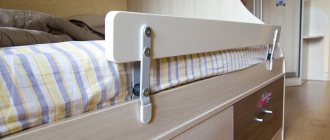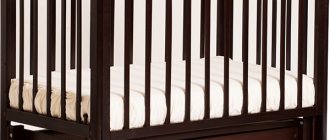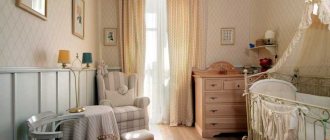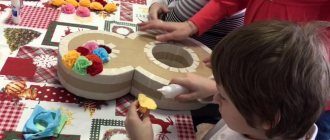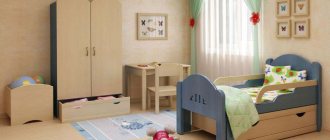So what is a furniture height group?
The very concept of “growth group” arose from considerations of the healthy development of the child’s body. To develop correct healthy posture in children, it is necessary that they not only lead an active lifestyle, but also sit correctly at their desks on the right chairs. For this purpose, height groups were developed, in which the height of the chair and table depend directly on the height of the child, and take into account the peculiarities of the child’s seating position.
Important! When selecting furniture, you need to consider that:
- with your knees bent 90 degrees, your feet should be in full contact with the floor;
- there must be a space of at least 110 mm between the knees and the tabletop for free movement,
- the front edge of the chair should not be closely adjacent to the popliteal hollows, the lower part of the thigh should be free from the pressure of the chair,
- the forearm of the hand, bent at the elbow 90 degrees, should lie calmly without tension on the tabletop,
- the back of the chair should provide back support in two places (lumbar region, lower part of the shoulder blades),
- There should be free space between the chair seat and the backrest.
All of the above conditions are met in growth groups. And knowing the height of your child, you no longer have to run around all the stores with a tape measure and try on furniture. It’s enough to just decide on this same growth group.
Table of height groups depending on the height of the child
| Child's height (mm) | Height group for furniture and marking color | Group in kindergarten or class at school (approximately) | Height from floor to chair seat (mm) | Height from floor to table top (mm) |
| 00 (black) | ||||
| 0 (white) | junior group | |||
| 1 (orange) | junior/middle group | |||
| 2 (purple) | middle/senior groups | |||
| 3 (yellow) | senior group/1st grade | |||
| 4 (red) |
Sanitary and epidemiological requirements for the design, content and organization of work in preschool organizations.
The current SanPiN 2.4.1.3049-13 was adopted on May 15, 2013, and came into force on July 30, 2013, replacing the expired SanPiN 2.4.1.2660-10. Extract from SanPiN 2.4.1.3049-13: For children aged 5 to 7 years, up to 8 hours of health-improving and educational activities per week should be provided among the necessary physical activity. In addition, it is necessary to include a complex for hardening the pupils, which consists of ventilating the premises, washing with cold water, exercises and a walk in the fresh air.
The exact standards for groups of different ages in the pool can be read in the text of the regulatory document. After visiting the pool, children can be taken out for a walk no earlier than 50 minutes later in order to prevent hypothermia.
Treatment
According to SanPin, ventilation of the premises of children's groups must be carried out repeatedly, during the absence of children. The duration of ventilation depends on the air temperature outside the window and the quality of heating in the room. Half an hour before children return to groups, ventilation should be stopped. In the warm season, ventilation is permissible in the presence of pupils; in this case, it is advisable to avoid drafts. The document contains a table that clearly indicates the duration of such procedures in a preschool institution.
According to SanPin, quartzing of groups in kindergarten must be carried out twice a day according to the schedule and then ventilated.
Washing and treating toys in kindergarten according to SanPin must be done daily after children go home. In the youngest groups - twice a day. Toys intended for playing outside are washed immediately after returning from the street. It is also necessary to treat toys that have just been purchased; this must be done with a soapy solution for 15 minutes, then rinsed in clean water. The detergent used to treat toys must be safe for children.
In accordance with SanPin standards, bed linen in a kindergarten should be changed as it gets dirty, but at least once a week. Washing of linen and towels is carried out either in the laundry of a preschool educational institution, or by a special organization with which an agreement has been drawn up for the provision of laundry services.
In accordance with sanitary standards, each child in a kindergarten group must have an individual potty, and for children over 5 years old, personal toilet seats made of safe materials must be installed on the toilets. Pots should be treated immediately after use using detergents and disinfectants. Toilets are cleaned at least twice a day.
Food department
Each kindergarten group must be equipped with a sink for washing dishes with hot and cold water in accordance with SanPin. The dishes are first cleaned of food residues, then washed with a sponge with the addition of mustard and soda. Next, wash in water at a temperature of 50 degrees with the addition of bleach, then rinse in water at least 70 degrees and dry on a wire rack designed for this purpose. The dishes should be boiled in clean water once every day.
If there is a suspicion of a disease transmitted through food, then the dishes should, after cleaning and washing, be processed and disinfected in a solution of chloramine or bleach for 30 minutes, then thoroughly rinsed and dried.
All utensils in the preschool educational institution must be marked in accordance with SanPin. Each pan should have an inscription for what dish it is intended for, the marking is applied with oil paint.
Fortification in kindergarten according to SanPin is carried out taking into account the condition of the pupil, with the mandatory supervision of a health worker and with notification of parents.
If the menu does not include fortified drinks, then vitamins are added to third courses - compote or jelly, at a certain temperature
Standards for premises and equipment
The SanPin for a swimming pool in a kindergarten clearly states what rooms should be near the pool and what they will be equipped with, as well as what kind of personnel is needed in the pool. Particular attention should be paid to cleaning and disinfecting the pool. If there is good water circulation in the pool, a complete water change should be done within 8 hours. If there is no circulation, the water should be drained daily. Cleaning of the swimming bowl must be carried out by the employees responsible for it. Showers, toilets and locker rooms are cleaned every day. General cleaning monthly. It is necessary to monitor the quality of water in the pool once a day.
Flowers are planted in the kindergarten yard to separate play areas from utility areas. According to SanPin, fruit-bearing, poisonous and thorny plants cannot be planted.
The size of furniture in a kindergarten according to SanPin must be of the same group and correspond to the table given in the decree. Each height group of children must correspond to the size of the furniture.
Furniture in a kindergarten must be marked according to SanPin by color, depending on the size of the furniture.
SanPin for staff
All personnel, including kindergarten teachers, must undergo a medical examination when hired. inspection and certification for knowledge of sanitary standards. Then, every two years, knowledge of the same standards is tested, and teachers are also regularly tested. For example, testing “Federal State Educational Standard for Preschool Education”. All preschool teachers are provided with special clothing.
According to the new SanPin, a kindergarten nurse must have at least a secondary medical education and have at least 3 years of work experience. Having a medical record is mandatory, and a medical examination must be carried out every three months. When working, relies on the document of proper instructions and internal labor regulations
You can learn more about the SanPin standards for preschool educational institutions by clicking on the link.
Rooms for children aged 1 to 4 years must have four-person tables; For the middle, senior and preparatory groups of kindergarten, double tables are used. Tables are placed in no more than 2 rows and in such a way that the light falls from the left. The distance from the blinding area of the window should be at least 0.45 m (preferably 1 m), and between rows at least 0.45 m.
For preschoolers, furniture is produced in 6 groups, which have the appropriate characteristics (Table 1.13).
Table 1.13.
Beds for kindergarten: how to choose suitable furniture
Furniture for a children's bedroom must meet a number of requirements.
Must be taken into account:
- child's height;
- environmental friendliness;
- non-toxic.
When choosing cribs for a kindergarten, you should pay attention to their color: the furniture should be light. Recently, pull-out cribs have been especially popular - they save space in small spaces. However, we must not forget about sanitary standards: there must be at least two square meters per child.
Furniture markings should also be chosen carefully. The numbers for cribs in kindergarten should be made in the same style; it is best to choose vinyl-based markings.
By the way, you can do gymnastics after sleep in kindergarten right in your crib! It is enough to find a suitable corrective charging complex. It will help the child to cheer up and strengthen the respiratory system.
Dimensions and markings of tables and chairs for preschool children.
| Furniture group | Marking color | Height group, cm | Table height above the floor, cm | Seat height above floor, cm |
Making children's beds
two types: I - children's bed with a fence and variable bed height for children under 3 years old; II - children's bed for children aged 3 to 7 years. Their functional dimensions are presented in Table 1.14.
Table 1.14.
Dimensions of school furniture and its markings.
| Furniture rooms | Height group, mm | Height above the floor of the table edge facing the student | Marking color | Height above the floor of the front edge of the seat |
| Orange | ||||
| Violet |
Furniture must be digitally and color coded
. The color coding of school furniture should be visible from the aisle between the rows; it is applied on both sides of the table (desk), chair in the form of a circle with a diameter of 22 mm or a horizontal strip with a width of 20 mm.
Table 1.16.
The school currently uses chalkboards
several types:
For writing with chalk;
For writing with a felt-tip pen;
For writing with chalk with a staff (musical);
Cork for advertisements.
Boards made from enameled steel sheet are convenient.
Depending on the color of the enamel, writing boards are used with chalk (green) and dry erase markers (white).
When equipping classrooms, the following passage dimensions and distances must be observed:
Between rows of double tables - at least 60 cm;
Between the rows of tables and the outer longitudinal wall - at least 50-70 cm;
Between the rows of tables and the internal longitudinal wall (partition) or cabinets standing along this wall - at least 50-70 cm;
From the last tables to the wall (partition) opposite the blackboard - at least 70 cm, from the rear wall, which is the outer wall - at least 100 cm, and if there are reversible classrooms - 120 cm;
From the demonstration table to the teaching board - at least 100 cm;
From the first desk to the blackboard - 2.4 - 2.7 m;
The greatest distance between a student’s last place and the blackboard is 860 cm;
The height of the bottom edge of the board above the floor is 80-90 cm.
Desks, tables and chairs are arranged in the classroom by number: smaller ones are closer to the blackboard, larger ones are further away; for children with reduced visual acuity and hearing, desks, regardless of size, are placed in front. If visual acuity is sufficiently corrected with glasses, students can sit in any row.
Schoolchildren with rheumatic diseases, who are often ill (sore throat, acute inflammation of the upper respiratory tract), must be seated further from the outer wall.
At least 2 times a year, students sitting in rows I and III are changed places, without disturbing the correspondence of the furniture to their body length.
The teacher's observation of the child during the lesson makes it possible to note deviations from the correct posture and subsequently determine their causes.
The width of the workplace at the table should be equal to the sum of the lengths of two forearms with hands, plus 3-4 cm for freedom of seating. The height of the chair should be equal to the length of the lower leg with an addition of 2 cm for the height of the heel.
The depth of the chair should be no less than 2/3 and no more than 3/4 of the length of the thigh.
It is necessary to pay special attention to cases when the dimensions of the desk (table), chair correspond to the dimensions of the person sitting behind them, and the child’s seat does not correspond
hygienic requirements. This indicates a lack of developed skill in proper landing.
Instructions
Select furniture according to the height of the children. Furniture for kindergarten is available in three sizes. It is possible that chairs and tables will have to be filed or, conversely, knocked down. As a rule, tables and chairs are marked with geometric shapes. Mark a table and a set of chairs intended for children of the same height with the same shape - a circle, triangle or square. Draw an icon on the corner of the table and the backs of the chairs. A variety of materials can be used for this. It is best to apply it with oil paint. You can cut out figures from colored paper, stick them on and varnish them. In this case, you should not use colored tape, as it peels off very quickly. Make a list of children who sit at the same table.
Lockers where children leave their clothes must also be labeled. Plexiglas pockets are very convenient for this. They are attached to the cabinet doors, and then a picture is inserted into them. But pockets are not always included in the package, so they need to be cut out. Thin plexiglass will do. Cut or order squares approximately 6x6cm in size and screw them to the doors. It is advisable to buy or make 3 identical sets of pictures so that the markings on the cabinets in the locker room and washroom, as well as on the cribs, are the same. Now special sets of pictures for marking are being produced; they are made of self-adhesive materials, so plexiglass pockets are optional.
Cots, as well as washroom cabinets, must be double labeled. The pictures are used to help children find their things. But cribs and towel lockers are also marked with numbers. Paint them with oil paint. Lists should also be compiled and posted in a visible place. The first column of such a list contains the number of the crib or locker, and the second column contains the child’s last and first name.
In a child care facility, kitchen utensils must be labeled. In a regular municipal kindergarten, children usually eat in a group. The nanny brings lunch. Each pan should be labeled with what dish it is intended for. The largest ones are marked “1 course”, “3 course”. A slightly smaller pan is reserved for the side dish and labeled “2nd course.” In it, the nanny brings porridge for breakfast. Separate dishes are needed for meat dishes, for salad and for bread. A corresponding inscription is made on each item. The markings are applied with oil paint.
It is also necessary to label the buckets that the nanny uses during wet cleaning. The same bucket can be used in the playroom and bedroom, but the toilet should have its own, appropriately marked. The same applies to floor rags. The one used to wash toilet floors should have a red marking on it. It could simply be a piece of red fabric sewn to a rag. Mops should also be marked.
In nursery groups, the teacher examines the children in the morning. He takes their temperature and looks at their throats. There should be 2 cans for spatulas. They also need to be marked with oil paint. On one there is the inscription “Clean spatulas”, on the other - “Dirty spatulas”.
The substrate consists of a ceramic element with a high alumina content. This gives very good insulation on which the resistive element is mounted.
Connections also play an important role. They must create reliable contact between the resistive element and the resistor chip, and also provide a high level of conductivity. This is achieved by using a nickel-based intermediate layer and a tin-based outer layer to ensure good soldering.
Surface mount resistors come in a variety of standard sizes. Technologies do not stand still and therefore the sizes of radio components are constantly decreasing. In 2014, the usual size for an SMD resistor was 0.05 millimeters.
Curtains and decorative elements: how to make sleep in kindergarten even sweeter?
Daytime naps are very important for preschoolers. Curtains will help make it comfortable, because falling asleep in the bright sun is not easy. Natural fabrics will help darken the room. Heavy curtains that do not allow any light to pass through at all would be inappropriate in a child’s bedroom.
When choosing curtains, you should pay attention to:
- their environmental friendliness - materials must be natural;
- compliance with fire safety standards;
- practicality;
- color scheme - it should be in harmony with the design of the room.
One of the current trends in window design in kindergarten bedrooms is blinds. They do not collect dust; you just need to wipe them regularly. This means that children with allergies will be safe! All structures designed to secure curtains must be reliable.
Don’t forget about beautiful bedspreads and unusual accessories: cute toys - sleeping cats, numbered lambs - are suitable for decorating the bedroom.
This is the kind of bedroom design in kindergarten that will help kids relax and completely immerse themselves in the incredible world of dreams and adventures!
Characteristics of SMD resistor
SMD resistors are manufactured by various companies. Therefore, the characteristics of elements with the same rating can differ greatly from each other. There are several basic parameters that you need to pay attention to.
The power rating requires special attention. For surface mount resistor designs, the level of power that can be dissipated is less than for wirewound components.
Due to the fact that SMD resistors are made using a metal oxide film, they have relatively similar tolerance values. However, deviations within 5, 2 and 1 percent are the most common. For special parts the values can be 0.5 and 0.1 percent.
SMD resistors usually have a good temperature coefficient. Values of 25, 50 and 100 units of pulse modulation per 1°C are most common.
Application
SMD resistors are used in many designs. Their size allows them to be used not only for compact boards, but also for automatic assembly methods. Another advantage is that they work well in radio applications. Due to their small size, such resistors have very little false inductance and capacitance. However, high levels of power dissipation must be taken into account when designing the electromagnetic circuit.
A kindergarten is a place where children spend most of the day, so it is important to furnish the room with furniture that is comfortable for sleeping. When choosing beds for a kindergarten, it is important to remember such qualities of furniture as environmental friendliness, comfort, and durability.
Children's beds have the following varieties:
- sliding bed - especially relevant for kindergartens without a separate bedroom. This model may have drawers, a small chest of drawers, removable sides, special mattresses;
- single-tier bed with sides or backrest. The latter can have a straight or semicircular shape, representing an animal or the sun;
- The kaleidoscope bed has an interesting stacked layout. One sleeping place is inserted into another, which is convenient when arranging furniture in a playroom, as well as for easier cleaning of the room;
- A roll-out crib saves space by rolling out one bed from another. This option is not entirely convenient for the younger group: the second section is at a decent height from the floor;
- a bunk bed is two sleeping places located on top of each other, with a ladder for greater convenience. This is a good space saver, but not for the youngest kindergarten visitors;
- the double-row model forms two beds separated by a partition. Thanks to such models, significant space is saved;
- the three-tier option is boxes with wheels for rolling out, which allows you to save a lot of space, protecting bed linen from contamination;
- the roll-out version of a three-tier bed also consists of three parts, the only difference being that the upper part slides into the bed frame;
- roll-out bed with a cover of three sections. Each seating area is of different heights and slides one under the other, with lids protecting bedding from dust. Roll-out models save space well, but are not recommended for younger family members;
- The roll-out bedside table model consists of two sections - this is a kind of large bedside table with roll-out drawers, which essentially serve as beds. The upper part slides into the body of the cabinet itself. There is an option with a lid for the top drawer.
Despite the variety of beds for kindergartens, single-tier models are mostly chosen. Multi-tiered products may raise safety issues, not to mention the stability of the models.
In any case, these qualities are tested during installation, and the conclusion is given by the head of the child care institution.
Double row
Bunk
Kaleidoscope
Single-tier
Fencing elements
Cribs require guards to prevent falls. Their appearance is related to the type of construction and the material used. Such devices can be made from:
- fabrics;
- plastic;
- metal;
- tree.
So, for children of the older group, the bed limiter is selected in medium sizes so that they can climb up without assistance and not fall during sleep. For greater emphasis, slits can also be made to cover part of the bed.
Very popular parts included with beds are barriers - removable or built-in. The first type has a horizontal base, which is placed under the mattress and is attached to the bed sides. They are supplied with racks that are adjustable for possible modification of the barrier height. Some contain retractable poles to position the bed rail at the desired distance from the edge. Built-in barriers are panels that are attached to the side of the bed. They do not have sharp corners, and the soft covering will protect the baby from possible injury while sleeping.
The preference for barriers as fencing elements has good reasons:
- feeling more protected and falling asleep faster;
- wide range of models;
- the mattress and blanket do not slide to the floor;
- no draft penetration.
When choosing beds and their protective elements, you should pay attention to the dimensions of the structure and the age group of the children. The thematic orientation of the premises also plays an important role.
Variety of models
Modern round cribs have many modifications.
Classic round or oval crib with four legs. It is made of wood, the bottom is height adjustable. There are modifications on wheels or on classic legs. Eco-friendly, but short-lived - the baby quickly grows out of such a crib
Suspended: there are rocking or pendulum models. A good model for very young children: here the baby is calm and falls asleep faster. But from such a cradle, an older baby can fall to the floor. This factor also needs to be taken into account when choosing a crib.
Oval side cot. On one side it has no side. Can be placed next to parents' bed. At the same time, the baby has his own personal space next to his mother.
Transformable bed. The advantages include its functionality and shelf life: cradle, playpen, crib, table with comfortable chairs.
It will be useful for a mature preschooler for fun games with peers and educational activities with mom. Such a crib is expensive and requires additional space in the baby’s room.
Thematic design
In kindergarten it is important to have a comfortable place to sleep. We also do not forget that the bedroom is a place of peace and comfort. But how every child wants to associate their bed with something fun and magical.
You can put drawings of your favorite characters from books and cartoons on ordinary beds. To do this, if the institution has the opportunity, you can invite a professional artist, or you can try to do this for the teachers, parents and children themselves. The creative process will add to your mood, and cute animals from fairy tales and princesses will be a continuation of your fairytale dream.
In addition to the bed itself, children's bedding plays an important role. Of course, first of all you need to pay attention to its environmental friendliness and dye stability. But for the child, you should also choose his favorite design - gentle and charming pictures, interesting plots, landscape paintings. And of course, the images of fairy tale characters and cartoon characters will make him happy to unpack his bed and go to bed. Or just light pastel colors that set you up for a restful and healthy sleep. But when choosing bedding, you should still avoid strong brightness and variegation, which will irritate the child.
The most daring decisions for bed design can be considered a departure from the standard shape. Vehicles will be the favorites here. A modern car bed is the dream of every boy, and a crib in the shape of a carriage is the dream of a little princess. The main thing is that such a solution is realistically feasible.
Quiet hour in kindergarten: how to create a peaceful atmosphere?
Very often, children refuse to sleep in preschool. They prefer noisy games with peers, musical activities and fun walks.
The task of the kindergarten staff is to create a calm and serene atmosphere in the bedroom. The resourceful designer who lives in every teacher is able to decorate a kindergarten bedroom with his own hands and turn it into a comfortable room for children to sleep and relax.
Child psychologists recommend:
- Avoid overly bright bedding. Children under five years old are not suitable for underwear with images of fairy-tale characters and cartoon characters. Children will be provided with a restful sleep during quiet time in kindergarten with sheets and duvet covers of a delicate yellow color; a win-win option is all “delicious” shades: caramel, chocolate, milk.
- For older children, favorite cartoon characters will become excellent companions to the kingdom of Morpheus. You can paint the walls in your bedroom with princesses, knights, and fairy-tale animals. Children of nursery groups will especially appreciate the drawings on the walls in the kindergarten: they will willingly go to bed if they are accompanied by cheerful monkeys, sleepy cats, and mischievous lion cubs.
- Do not paint irritating, frightening or too bright, colorful images on the walls. Use such drawings for the children's bedroom that will encourage the kids to relax and set them up for sleep.
- if painting walls in a kindergarten is too troublesome for you or impossible for some other reason, you can use large vinyl stickers or decorate the wall with holographic paper stars.
Quality and compliance with GOSTs
Two main GOSTs are related to the types of cribs produced for kindergartens, as well as testing their quality. Models intended for a nursery group must have a reliable fence and be able to modify the height of the bed as the baby grows. The length of the product should not exceed 1 m 20 cm, and the width - 0.6 m. If the crib has the function of moving the side rail down, then it should be lowered by no less than 13.5 cm.
A bed intended for children from 3 to 7 years old must be at least 1 m 40 cm, and the same width as the previous type. At the same time, the width can be made larger.
In the basic areas of testing beds in kindergartens, the following settings according to GOST are important:
- structural stability;
- degree of deformability of bed posts;
- foundation strength;
- overall durability of the product.
Fresh products should be taken for testing, and the protocols of all inspections should contain possible deviations from installation standards, which were revealed by control. In addition, among the important requirements for children's equipment in the garden are sanitary and epidemiological rules for design and maintenance, confirmed by certificates. And beds, like any piece of furniture, must be resistant to the use of various wet cleaning products.
Bedroom in kindergarten: what color to choose?
The color of the walls in a kindergarten bedroom is usually determined by the placement of the room:
- for a bedroom oriented to the west or north, warm shades are suitable;
- cold colors are acceptable in children's rooms with windows facing east or south.
Suitable materials for wall decoration include:
- washable wallpaper;
- dye.
A few more important tips for those who are decorating a bedroom in a preschool educational institution with their own hands:
- The experience of teaching staff shows that children fall asleep well in pastel-colored rooms;
- the walls can be plain, or you can use several shades, but the transition between them should be soft;
- rich, rich colors are suitable only for small color areas;
- The best option for a bedroom in a kindergarten is walls painted in a delicate lilac color, with small bright patterns.
| Surface | Materials | Shades |
| Ceiling | Whitewash | Light, can be painted in the form of a starry sky |
| Walls | Wallpaper, paint | Not very bright, pastel, painted using stencils |
| Floor | Linoleum | Harmony with the interior is required |
